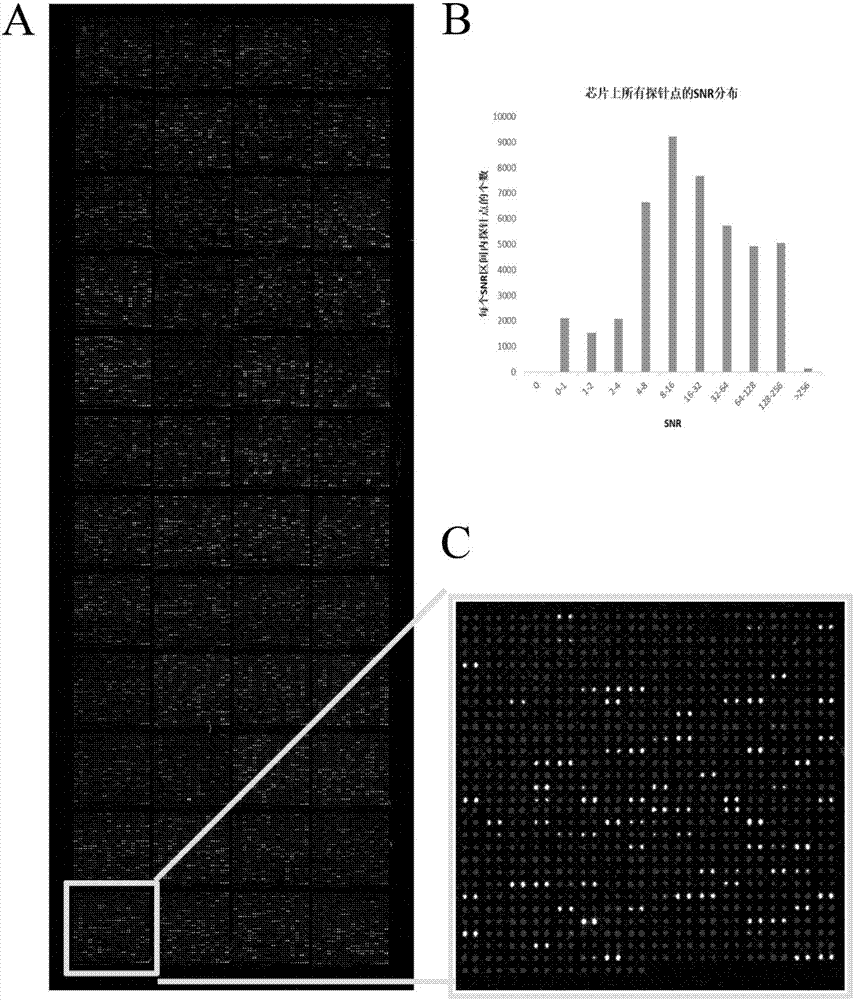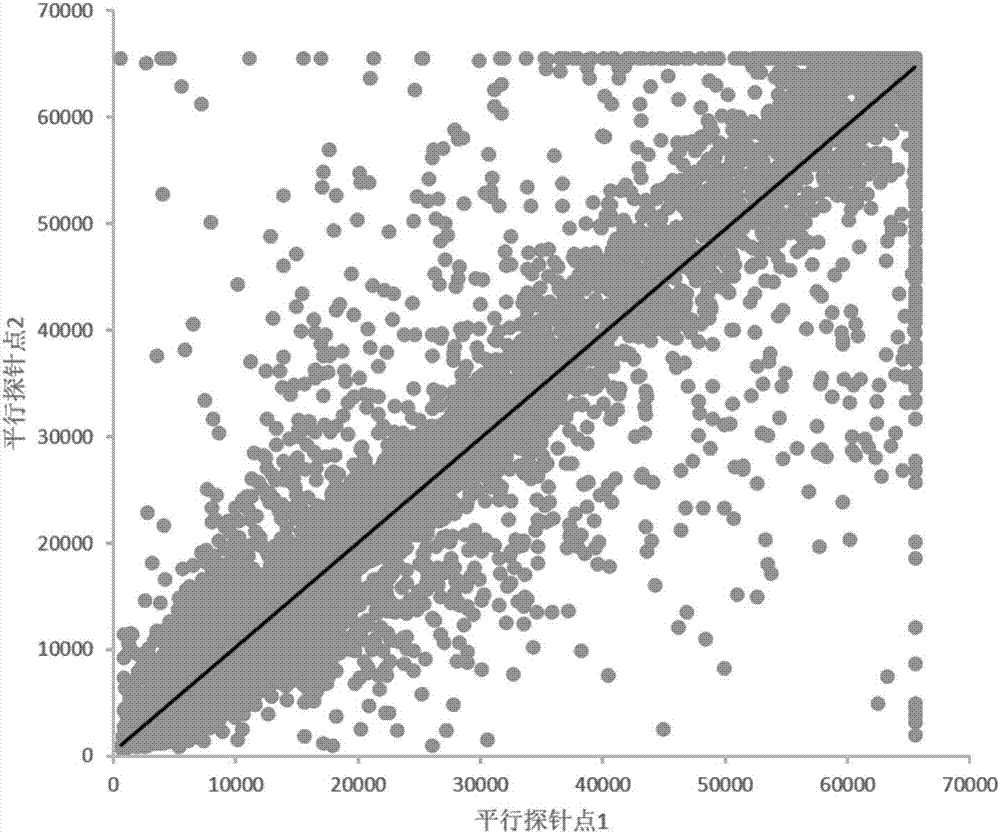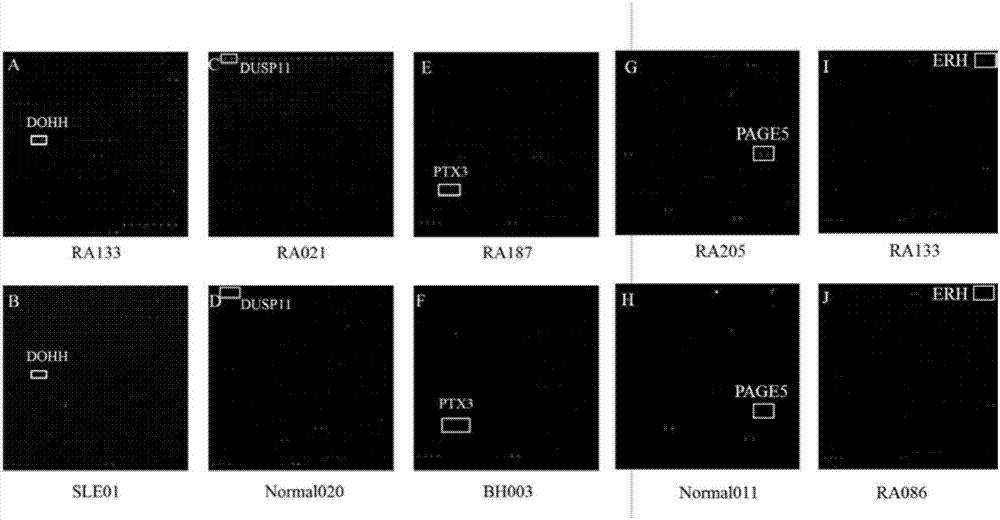Diagnosis marker for ACPA-negative RA and application thereof
A negative and versatile technology, applied in the field of RA diagnostic markers, can solve problems such as molecular characteristics of affected joints, differences in remission rate and response rate
- Summary
- Abstract
- Description
- Claims
- Application Information
AI Technical Summary
Problems solved by technology
Method used
Image
Examples
Embodiment 1
[0054] Example 1 High-density protein chip screening candidate RA autoantigens
[0055] The high-density protein chip and the expression recombinant plasmid of Saccharomyces cerevisiae containing the target gene sequence were provided by the laboratory of Professor Zhu Heng of Johns Hopkins University in the United States. Each high-density protein chip contains 48 microarrays (blocks), and each microarray contains 992 probe points, arranged in a 32*31 array, and each protein probe on the chip has 2 parallel points. The protein chip contains 21827 non-redundant recombinant human proteins. The recombinant protein comes from the full-length open reading frame (open reading frame, ORF) of the corresponding gene expressed by the Saccharomyces cerevisiae host, and its N-terminus has a glutathione S-transferase (glutathione S-transferase, GST) tag.
[0056] Use the mouse anti-GST monoclonal antibody to hybridize with the chip to verify the quality of the chip. When the correlation ...
Embodiment 2
[0058] Example 2 Hybridization of high-density protein chips with RA and control serum
[0059] Select 60 RA sera and 60 control sera (10 Behcet's disease sera, 10 Takayasu arteritis sera, 10 SLE sera and 30 healthy human sera) to hybridize with 120 chips, and identify candidates through signal acquisition and data analysis RA autoantigens. Anti-human IgG antibodies labeled with PE-Cy5 were used to detect the reaction of autoantibodies in serum with corresponding autoantigen probes. image 3 Shown are the representative local image results after the high-density protein chip was reacted with serum, and the different protein antigen probes are in the box. A, C, E, and G show schematic diagrams of hybridization of four RA sera to the chip. B, D, F, H show the schematic diagrams of hybridization of four control sera (including healthy control and disease control) with the chip. Panel I is a schematic diagram of RA that is effective in treatment, and panel J is a schematic diag...
Embodiment 3
[0073] Example 3 Construction of RA autoantigen protein chip and verification of serum screening
[0074] A total of 46 candidate RA autoantigens were screened by analyzing the hybridization results of high-density protein chip and small sample serum. In order to verify the specificity and sensitivity of these autoantigens, the present invention prepared a RA autoantigen protein chip with low probe density. Table 2 is the microarray layout of each probe on the RA autoantigen protein chip. The probes on the chip included 46 candidate RA autoantigens screened by the large chip and 5 control IGHG1 probes.
[0075] Table 2 The microarray layout of each probe on the RA autoantigen protein chip
[0076] AK2 IGHG1 ND ATP13A5 ND TBC1D19 RAB35 UBXN10 RAB3D APH1A TNFAIP1 HDAC4 ARL2BP RAI14 RRN3 POLR3B ERH NDRG1 BLANK BLANK BLANK BLANK BLANK GARS SUGT1 IGHG1 NOL3 ZSCAN20 LSP1 RGCC EMPTY PAGE5 FGF12...
PUM
 Login to View More
Login to View More Abstract
Description
Claims
Application Information
 Login to View More
Login to View More - R&D
- Intellectual Property
- Life Sciences
- Materials
- Tech Scout
- Unparalleled Data Quality
- Higher Quality Content
- 60% Fewer Hallucinations
Browse by: Latest US Patents, China's latest patents, Technical Efficacy Thesaurus, Application Domain, Technology Topic, Popular Technical Reports.
© 2025 PatSnap. All rights reserved.Legal|Privacy policy|Modern Slavery Act Transparency Statement|Sitemap|About US| Contact US: help@patsnap.com



